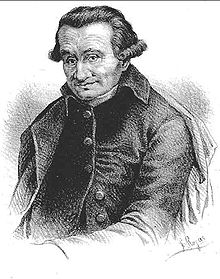- Juan Ignacio Molina
-
Juan Ignacio Molina Born June 24, 1740
Guaraculén, ChileDied September 12, 1829 (aged 89)
Bologna, ItalyFr. Juan Ignacio Molina (June 24, 1740 – September 12, 1829) was a Chilean Jesuit priest, naturalist, historian, botanist, ornithologist and geographer. He is usually referred to as Abate Molina (form of Abbott Molina), and is also sometimes known by the Italian form of his name, Giovanni Ignazio Molina.
Contents
Biography
Molina was born at Guaraculén a big farm located near Villa Alegre, in the current province of Linares, in the Maule Region of Chile. His parents were Agustín Molina and Francisca González Bruna.
He was educated at Talca and the Jesuit College at Concepción. He was forced to leave Chile in 1768 when the Jesuits were expelled. He settled in Bologna and became professor of natural sciences there. He wrote Saggio sulla Storia Naturale del Chili[1] (1782), which was the first account of the natural history of that country, and described many species to science for the first time.
Scientific work
As a scientist native to the Americas Molina was very critical of the work Cornelius de Pauw who was in Europe regarded an expert on the Americas and accused him of "always attempting to degrade and discredit the Americas". Some of Pauw's statements on the supposedly poor aspects of the mineral wealth of the Americas were countered by Molina as well as Pauw's claims on the shorter lives of people that inhabited the Americas.[2]
Molina expressed support for a sedimentary origin of basalt in Ensayo sobre la historia natural de Chile where he pointed out the fact that basalt occurred both in the Andes and in coast of Chiloé where there were no sign of eruption and believed basalt to be a sort of compacted slate with vesicles.[2]
As early as 1787 Molina mentioned the possibility of South America being populated from south Asia through the "infinite island chains" of the Pacific while North America could have been populated from Siberia.[3]
Botanical taxonomy
Ruiz and Pavon dedicated him Molina, later considered a subgenus of Baccharis by Heering (Reiche 1902), and recently F. H. Hellwig recreated as Neomolina and ranked as genus. Other authors dedicated Moliniopsis, a genus of Gramineae, as synonym of Molinia Schrank nom.illeg. Molina has also been linked to the naming of the genus Maytenus.
Additional information
See also
- Miguel de Olivares
- Alonso de Ovalle
- List of Jesuit scientists
- List of Roman Catholic scientist-clerics
Notes
- ^ Translated into English as The Geographical, Natural and Civil History of Chili, in two volumes. Volume I,Volume II
- ^ a b ENSAYO SOBRE LA HISTORIA NATURAL DE CHILE. Juan Ignacio Molina
- ^ The Geographical, Natural and Civil History of Chili, Volume II
- ^ "Author Query". International Plant Names Index. http://www.ipni.org/ipni/authorsearchpage.do.
Sources
- Hellwig, H. F. (1993). The genera Pingraea Cassini and Neomolina Hellwig Candollea. 48. Santiago, Chile. p. 212. http://www.darwin.edu.ar/Publicaciones/Darwiniana/Vol39(1-2)/d39_131-154.pdf
- Reiche, K. F. (1902) (in Spanish). Estudios críticos sobre la flora de Chile. Anales de la Universidad de Chile. 111. Santiago, Chile. pp. 153–183
 "Juan Ignacio Molina". Catholic Encyclopedia. New York: Robert Appleton Company. 1913.
"Juan Ignacio Molina". Catholic Encyclopedia. New York: Robert Appleton Company. 1913.

This article about a member of the Christian clergy is a stub. You can help Wikipedia by expanding it.

